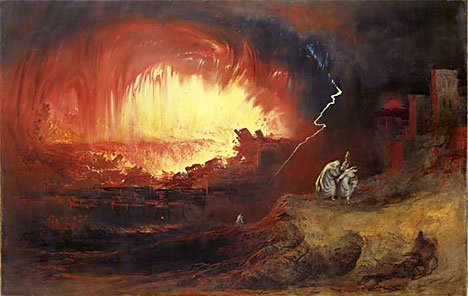Dec
3
2011
1 Peter 2:4-10 | Sermon Notes

The Stoning of Israel
I think it’s worth looking at the literary structure of this passage. Here’s a revised version of the sheet I handed out after the sermon.
As I’ve written before, modern readers (and commentators) only look at the content of the text, but the authors of Scripture also communicate to us through where they place that content within that text, i.e. how it is arranged.
Continue reading
1 comment | tags: Baptism, Covenant curse, Covenant Theology, Literary Structure, Lot, Moses, Peter, Ruth, Systematic typology, Tabernacle, The Law, Typology | posted in Bible Matrix, Biblical Theology
Nov
24
2011
In a universe of types and symbols, everything is self-effacing. Everything created points to, speaks of, something else in creation, and all creation ultimately points us back to the Trinity, the Perfect Unself.
Comments Off | tags: Trinity, Typology | posted in Biblical Theology, Creation
Nov
4
2011

Vance and his girlfriend wondered whether attending Bully’s Bible study was as safe as they’d been led to believe.
When I first read some James Jordan, I found it a little strange. He forced me to think in new ways. Now I wonder why nobody else seems to think this way. I make a glib reference to “knife and fire” and get strange looks. Has no one before Jordan realised the process of barbecue as an illustration of reality?
Continue reading
Comments Off | tags: Typology | posted in Bible Matrix, Biblical Theology
Sep
21
2011

William Booth’s eldest daughter, Founder of the Salvation Army in France and Switzerland, known later in life as “the Maréchale,” said, “Go for souls, and go for the worst.” So should we. After all, Jesus does.
Continue reading
Comments Off | tags: Baptism, C. S. Lewis, Power of the Gospel, Typology | posted in Christian Life, Quotes
Aug
6
2011

More than thirty years after the release of their hit song, “Down Under,” (1978) Australian rock band Men at Work were hauled into court for ripping their flute riff from a nursery rhyme. The issue came up after discussion on a popular rock quiz TV show. [1]
Most Aussies of my generation knew the original (really uncool) song, and the use of it as a motif in a rock song was, well, really cool. The very fact that it didn’t have a big yellow sticker on it saying “This bit is from Kookaburra,” and the listener picked it up, was gratifying. All good music does this. All good movies do this. TV shows also use subtle allusions to past episodes as a nod to faithful viewers (and no show does it with the concrete-cracking understatement of Mad Men).
In this case of the flute riff, any dunderhead could pick it up. While I think that the current owners of the copyright, Larrikin Records, are a bunch of opportunistic bastards (and though they were once considered indie and cool, I guess they are now really uncool), it pains me that modern teachers of the Bible are too cautious to read the Scriptures in this way, too conservative to pick up the motifs, phrases and structural allusions that are obvious once they are pointed out. They are looking for the big yellow sticker, and it ain’t coming.
Continue reading
3 comments | tags: Darren Doane, Hermeneutics, James Jordan, Music, Systematic typology, Typology | posted in Biblical Theology, Quotes
Jul
13
2011

In Against Christianity (pp. 56-58), Peter Leithart writes:
One of the contributions of twentieth-century Catholic nouvelle theologie, and of Henri de Lubac and Hean Danielou in particular, was a rehabilitation of patristic and medieval typological exegesis of the Bible. Typological interpretation assumes that events and institutions of the Old Testament present, to use Augustine’s terminology, “latent” pictures of Christ. Typological interpretation, in short, sees the whole Bible as gospel, with the gospel narrowly conceived (the story of Jesus) as the culmination of a larger story.
Continue reading
9 comments | tags: Ecclesiology, Peter Leithart, Secular humanism, Typology | posted in Biblical Theology, Quotes
Jun
27
2011

How can we fix modern worship? Nearly all debate on this subject overlooks what the Bible has to say.
In From Silence to Song, Peter Leithart justifies the practice of finding patterns for our worship in the Levitical rites in the fact that King David did precisely this.
“…sacrificial worship did not cease with the coming of the New Covenant, but was transformed into a “spiritual sacrifice” and “sacrifice of praise.” We now do different things than ancient Israelites did, but those actions have the same meaning as the actions in the Levitical ceremonies.
Continue reading
2 comments | tags: Chronicles, Communion, David, Leviticus, Liturgy, Peter Leithart, Typology, Worship | posted in Biblical Theology, Quotes
Jun
17
2011

Doug Wilson writes:
“It is of course true that real religion is concerned with the state of the heart, and not with whether a man has jumped through all the right ceremonial hoops. When a man believes the covenant promise he points away from himself . . . To look away from the heart to an objective Christ is not to neglect the heart; to look away in this fashion is the only way to be justified and put right with God” (To a Thousand Generations, p. 46).
This is an excellent statement. It’s perfect fruit for a pie but Pastor Wilson is sticking it in a casserole.
Continue reading
15 comments | tags: Baptism, Circumcision, Covenant Theology, Doug Wilson, Federal Vision, Laver, Tabernacle, Typology | posted in Biblical Theology, Quotes
Jun
13
2011

Someone made the comment that the “Bible Matrix” is something mystical. While it is certainly typological, it is not mystical. And it is only typological because it is the process of maturity God has built into everything under heaven. Trees and men grow up and bear fruit. That’s typology.
Continue reading
2 comments | tags: Amillennialism, Covenant Theology, James Jordan, Millennium, Postmillennialism, Revelation, Revelation 20, Satan, Typology | posted in Against Hyperpreterism, Bible Matrix, Biblical Theology, The Last Days
Jun
8
2011

The debate over infant baptism at Doug Wilson’s blog continues. Pastor Wilson writes:
“The Gentiles were threatened with removal from the same tree the unbelieving Jews had been in. But if this were the tree of salvation, then the elect can lose their salvation — which cannot be defended biblically. And if this is the tree of the covenant, then the point stands” (To a Thousand Generations, p. 36)
This looks logical enough, but trees are a process of maturity, from seed to fruit. So is righteousness, and so is sin.
Continue reading
28 comments | tags: AD70, Baptism, Booths, Doug Wilson, Feasts, Restoration, Revelation, Romans, Tabernacles, Typology | posted in Bible Matrix, Biblical Theology, Quotes, The Last Days, The Restoration Era


































